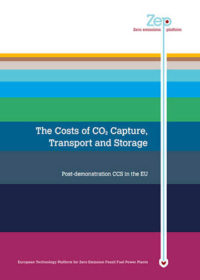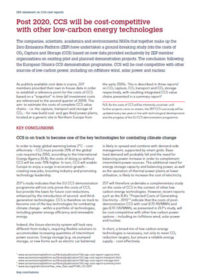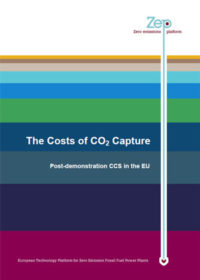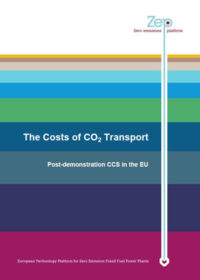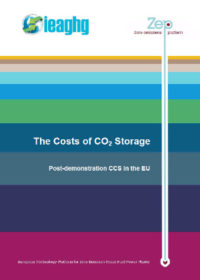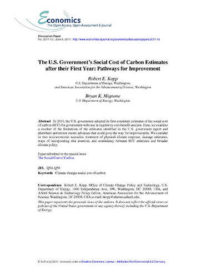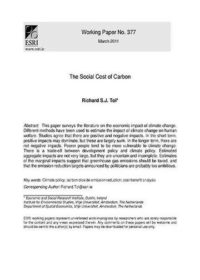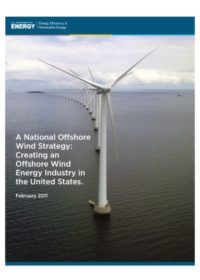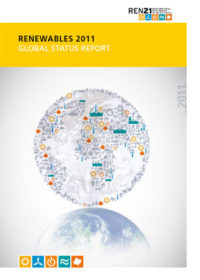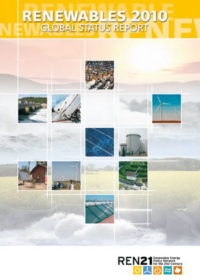Resources
Publications
Our publications, reports and research library hosts over 500 specialist reports and research papers on all topics associated with CCS.
View our Publication Library Disclaimer.
Filter by
The costs of CO2 capture, transport and storage: Post-demonstration CCS in the EU
20th July 2011
Topic(s): Carbon capture use and storage (CCUS), Economics
ZEP is an advisor to the European Union on the research demonstration and deployment of CCS. The ZEP’s Taskforce Technology has undertaken a study into the costs of complete CCS value chains – i.e. the capture, transport and storage of CO2 – estimated for new-build coal- and natural gas-fired power plants, located at a generic site in Northern Europe from the early 2020s. Utilising new, in-house data provided by ZEP member organisations, it establishes a reference point for the costs of CCS, based on a 'snapshot' in time (all investment costs are referenced to the second quarter of 2009).
Three Working Groups were tasked with analysing the costs related to CO2 capture, CO2 transport and CO2 storage respectively. The resulting integrated CCS value chains, based on these three individual reports, are presented in this summary report. For a complete picture of how the results were obtained, and all underlying assumptions, please refer to the three individual reports.
CO2 Capture Cost report
CO2 Transport Cost report
CO2 Storage Cost report
The overall report’s key conclusions are as follows:
Post 2020, CCS will be cost-competitive with other low-carbon energy technologies
The EU CCS demonstration programme will not only validate and prove the costs of CCS technologies, but form the basis for future cost reductions, enhanced by the introduction of second- and third-generation technologies. The results of the study therefore indicate that post-demonstration CCS will be cost competitive with other low-carbon energy technologies as a reliable source of low-carbon power. CCS is on track to become one of the key technologies for combating climate change – within a portfolio of technologies, including greater energy efficiency and renewable energy.
CCS is applicable to both coal-and natural gas-fired power plants
CCS can technically be applied to both coal- and natural gas-fired power plants. Their relative economics depend on power plant cost levels, fuel prices and market positioning, whereas applicability is mainly determined by load regime.
All three CO2 capture technologies could be competitive once successfully demonstrated
The study includes the three main capture technologies (post-combustion, pre-combustion and oxy-fuel), but excludes second-generation technologies (e.g. chemical looping, advanced gas turbine cycles). Using agreed assumptions and the Levelised Cost of Electricity as the main quantitative value, there is currently no clear difference between any of the capture technologies and all could be competitive in the future once successfully demonstrated. The main factors influencing total costs are fuel and investment costs.
Early strategic planning of large-scale CO2 transport infrastructure is vital to reduce costs
Clustering plants to a transport network can achieve significant economies of scale – in both CO2 transport and CO2 storage in larger reservoirs, on- and offshore. Large-scale CCS therefore requires the development of a transport infrastructure on a scale matched only by that of the current hydrocarbon infrastructure. As this will lead to greatly reduced long-term costs, early strategic planning is vital – including the development of clusters and over-sized pipelines – with any cross-border restrictions removed.
A risk-reward mechanism is needed to realise the significant aquifer potential for CO2 storage
Location and type of storage site, reservoir capacity and quality are the main determinants for the costs of CO2 storage: onshore is cheaper than offshore; depleted oil and gas fields (DOGF) are cheaper than deep saline aquifers (SA); larger reservoirs are cheaper than smaller ones; high injectivity is cheaper than poor injectivity. Given the large variation in storage costs (up to a factor of 10) and the risk of investing in the exploration of SA that are ultimately found to be unsuitable, a risk-reward mechanism is needed to realise their significant potential and ensure sufficient storage capacity is available – in the time frame needed.
CCS requires a secure environment for long-term investment
Based on current trajectories, the price of Emission Unit Allowances (EUAs) under the EU Emissions Trading System will not, initially, be a sufficient driver for investment after the first generation of CCS demonstration projects is built (2015-2020). Enabling policies are therefore required in the intermediate period – after the technology is commercially proven, but before the EUA price has increased sufficiently to allow full commercial operation. The goal: to make new-build power generation with CCS more attractive to investors than without it.
Disclaimer
The content within the Global CCS Institute Publications, Reports and Research Library is provided for information purposes only. We make every effort and take reasonable care to keep the content of this section up-to-date and error-free. However, we make no claim as to its accuracy, currency or reliability.
Content and material featured within this section of our website includes reports and research published by third parties. The content and material may include opinions and recommendations of third parties that do not reflect those held by the Global CCS Institute.
Post 2020, CCS will be competitive with other low-carbon energy technologies
15th July 2011
Topic(s): Carbon capture use and storage (CCUS), Economics
The companies, scientists, academics and environmental NGOs that together make up the Zero Emissions Platform (ZEP) have undertaken a ground-breaking study into the costs of CCS based on new data provided exclusively by ZEP member organisations on existing pilot and planned demonstration projects. Costs for different CCS options were determined using data for postcombustion, pre-combustion and oxy-fuel capture technologies, pipeline and shipping transport and storage in on and offshore depleted oil and gas fields and deep saline aquifers. This report summarises the key conclusions of the study.
Disclaimer
The content within the Global CCS Institute Publications, Reports and Research Library is provided for information purposes only. We make every effort and take reasonable care to keep the content of this section up-to-date and error-free. However, we make no claim as to its accuracy, currency or reliability.
Content and material featured within this section of our website includes reports and research published by third parties. The content and material may include opinions and recommendations of third parties that do not reflect those held by the Global CCS Institute.
The costs of CO2 capture: post-demonstration CCS in the EU
15th July 2011
Topic(s): Carbon capture use and storage (CCUS), CO2 capture, Economics
The companies, scientists, academics and environmental NGOs that together make up the Zero Emissions Platform (ZEP) have undertaken a ground-breaking study into the costs of CO2 capture based on new data provided exclusively by ZEP member organisations on existing pilot and planned demonstration projects. This report describe costs associated with the capture process and the conditioning and compression/liquefaction of the captured CO2 required for transport. The technologies studied are first-generation capture technologies, namely post-combustion CO2 capture, IGCC with pre-combustion capture and oxy-fuel for hard coal, lignite and natural gas.
Disclaimer
The content within the Global CCS Institute Publications, Reports and Research Library is provided for information purposes only. We make every effort and take reasonable care to keep the content of this section up-to-date and error-free. However, we make no claim as to its accuracy, currency or reliability.
Content and material featured within this section of our website includes reports and research published by third parties. The content and material may include opinions and recommendations of third parties that do not reflect those held by the Global CCS Institute.
The costs of CO2 transport: post-demonstration CCS in the EU
15th July 2011
Topic(s): Carbon capture use and storage (CCUS), CO2 transport, Economics
The companies, scientists, academics and environmental NGOs that together make up the Zero Emissions Platform (ZEP) have undertaken a ground-breaking study into the costs of CO2 transport based on new data provided exclusively by ZEP member organisations on existing pilot and planned demonstration projects. This report describes three methods of transportation namely onshore pipeline transport, offshore pipeline transport and ship transport.This report presents detailed cost elements and key cost drivers for each transport method.
Disclaimer
The content within the Global CCS Institute Publications, Reports and Research Library is provided for information purposes only. We make every effort and take reasonable care to keep the content of this section up-to-date and error-free. However, we make no claim as to its accuracy, currency or reliability.
Content and material featured within this section of our website includes reports and research published by third parties. The content and material may include opinions and recommendations of third parties that do not reflect those held by the Global CCS Institute.
The costs of CO2 storage: post-demonstration CCS in the EU
15th July 2011
Topic(s): Carbon capture use and storage (CCUS), CO2 storage, Economics
The companies, scientists, academics and environmental NGOs that together make up the Zero Emissions Platform (ZEP) have undertaken a ground-breaking study into the costs of CO2 storage based on new data provided exclusively by ZEP member organisations on existing pilot and planned demonstration projects. This report describes the bottom-up approach taken using cost components provided by ZEP members. In order to cover the range of potential storage configurations and still provide reliable cost estimates, storage was divided into six main typical cases, according to major differentiating elements. Including depleted oil and gas fields (DOGF) vs. deep saline aquifers (SA), offshore vs. onshore, and whether existing wells were re-usable.
Disclaimer
The content within the Global CCS Institute Publications, Reports and Research Library is provided for information purposes only. We make every effort and take reasonable care to keep the content of this section up-to-date and error-free. However, we make no claim as to its accuracy, currency or reliability.
Content and material featured within this section of our website includes reports and research published by third parties. The content and material may include opinions and recommendations of third parties that do not reflect those held by the Global CCS Institute.
The U.S. Government’s social cost of carbon estimates after their first year: pathways for improvement
8th June 2011
Topic(s): Economics, Social cost
Disclaimer
The content within the Global CCS Institute Publications, Reports and Research Library is provided for information purposes only. We make every effort and take reasonable care to keep the content of this section up-to-date and error-free. However, we make no claim as to its accuracy, currency or reliability.
Content and material featured within this section of our website includes reports and research published by third parties. The content and material may include opinions and recommendations of third parties that do not reflect those held by the Global CCS Institute.
Disclaimer
The content within the Global CCS Institute Publications, Reports and Research Library is provided for information purposes only. We make every effort and take reasonable care to keep the content of this section up-to-date and error-free. However, we make no claim as to its accuracy, currency or reliability.
Content and material featured within this section of our website includes reports and research published by third parties. The content and material may include opinions and recommendations of third parties that do not reflect those held by the Global CCS Institute.
2050 pathways analysis: response to the call for evidence. Part 1
1st March 2011
Topic(s): Economics, Renewables
In July 2010, the Government published its 2050 Pathways Analysis work. The analysis explored a range of potential pathways, choices and trade-offs for achieving long-term greenhouse gas emissions reduction target and ensuring the UK’s energy needs are met.
The 2050 Pathways Analysis was published as a Call for Evidence, running from 27th July to 5th October 2010. The questions on which evidence was sought are set out in Annex A. The United Kingdom’s Department of Energy and Climate Change (DECC) published the analysis as a Call for Evidence in order to test with a wider range of experts and stakeholders whether the assumptions and data underpinning the model were considered to be sound and based on the best available evidence.
The response to the Call for Evidence was very positive. The overwhelming opinion was that the 2050 Pathways Analysis was a valuable tool and a useful contribution to the debate about the United Kingdom’s energy future.
This report sets out how DECC revised the model, and the evidence and assumptions that underlie the changes they made (see Part 2A).
Disclaimer
The content within the Global CCS Institute Publications, Reports and Research Library is provided for information purposes only. We make every effort and take reasonable care to keep the content of this section up-to-date and error-free. However, we make no claim as to its accuracy, currency or reliability.
Content and material featured within this section of our website includes reports and research published by third parties. The content and material may include opinions and recommendations of third parties that do not reflect those held by the Global CCS Institute.
A national offshore wind strategy: creating an offshore wind energy industry in the United States
7th February 2011
Topic(s): Economics, Offshore wind, Renewables, Wind energy
A National Offshore Wind Strategy: Creating an Offshore Wind Energy Industry in the United States was prepared by the U.S. Department of Energy’s (DOE) Office of Energy Efficiency and Renewable Energy (EERE) Wind and Water Power Program to outline the actions it will pursue to support the development of a world‐class offshore wind industry in the United States.
This report describes how offshore wind energy can help the United States reduce its greenhouse gas emissions, diversify its energy supply, provide cost‐competitive electricity to key coastal regions, and stimulate revitalization of key sectors of the economy by investing in infrastructure and creating skilled jobs.
Disclaimer
The content within the Global CCS Institute Publications, Reports and Research Library is provided for information purposes only. We make every effort and take reasonable care to keep the content of this section up-to-date and error-free. However, we make no claim as to its accuracy, currency or reliability.
Content and material featured within this section of our website includes reports and research published by third parties. The content and material may include opinions and recommendations of third parties that do not reflect those held by the Global CCS Institute.
Renewables 2011 global status report
1st January 2011
Topic(s): Economics, Global Status Report, Policy law and regulation, Renewables
Changes in renewable energy markets, investments, industries, and policies have been so rapid in recent years that perceptions of the status of renewable energy can lag years behind the reality. This report captures that reality and provides a unique overview of renewable energy worldwide as of early 2011. The report covers both current status and key trends; by design, it does not provide analysis or forecast the future.
Disclaimer
The content within the Global CCS Institute Publications, Reports and Research Library is provided for information purposes only. We make every effort and take reasonable care to keep the content of this section up-to-date and error-free. However, we make no claim as to its accuracy, currency or reliability.
Content and material featured within this section of our website includes reports and research published by third parties. The content and material may include opinions and recommendations of third parties that do not reflect those held by the Global CCS Institute.
Renewables 2010 global status report
1st September 2010
Topic(s): Domestic policy, Economics, Geothermal energy, Global Status Report, Hydroelectricity, Marine energy, Policy law and regulation, Renewables, Solar energy, Wind energy
Changes in renewable energy markets, investments, industries, and policies have been so rapid in recent years that perceptions of the status of renewable energy can lag years behind the reality. This report captures that reality and provides a unique overview of renewable energy worldwide as of early 2010. The report covers both current status and key trends. By design, the report does not provide analysis, discuss current issues, or forecast the future.
Disclaimer
The content within the Global CCS Institute Publications, Reports and Research Library is provided for information purposes only. We make every effort and take reasonable care to keep the content of this section up-to-date and error-free. However, we make no claim as to its accuracy, currency or reliability.
Content and material featured within this section of our website includes reports and research published by third parties. The content and material may include opinions and recommendations of third parties that do not reflect those held by the Global CCS Institute.
Building a low carbon economy: the UK’s innovation challenge
19th July 2010
Topic(s): Carbon capture use and storage (CCUS), Economics, Energy efficiency, Marine energy, Nuclear fission, Offshore wind, Policy law and regulation, Renewables, Wind energy
This report considers the effectiveness of current policy measures and institutional arrangements to deliver the technologies required to meet the UK’s 2050 emissions target.
Disclaimer
The content within the Global CCS Institute Publications, Reports and Research Library is provided for information purposes only. We make every effort and take reasonable care to keep the content of this section up-to-date and error-free. However, we make no claim as to its accuracy, currency or reliability.
Content and material featured within this section of our website includes reports and research published by third parties. The content and material may include opinions and recommendations of third parties that do not reflect those held by the Global CCS Institute.
